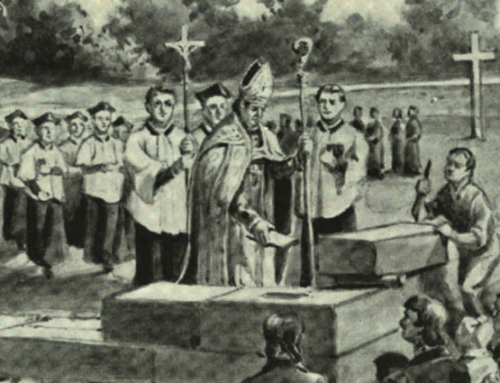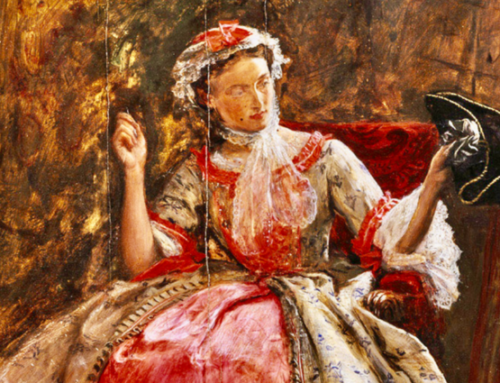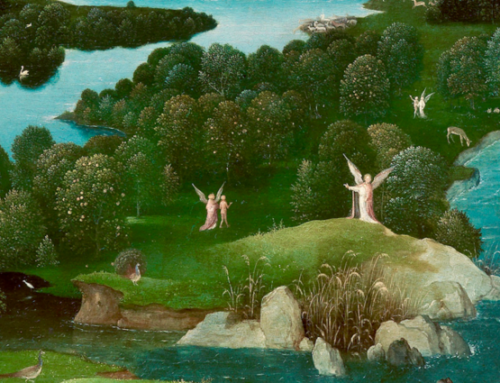In a world with central heating and agribusiness, the natural family is the last direct connection most people have to a natural order. With its demise, traditional religion loses an important justification for its sacrifices.
How the West Really Lost God by Mary Eberstadt (268 pages, Templeton Press, 2013)
 We can hope that Western civilization is in the early stages of awakening from a bad dream. Mary Eberstadt’s new book may help with that. It is more a stirring nudge than a blaring alarm—in part because it is an accessible work of social science, not a moral treatise. Throughout, she reassures us that she is just looking for the truth—the truth being amoral and merely factual in this case. Apart from my own doubts about the possibility or desirability of knowing facts as such, anyone who favors life over death, or meaning over the void, cannot help but feel a moral stirring.
We can hope that Western civilization is in the early stages of awakening from a bad dream. Mary Eberstadt’s new book may help with that. It is more a stirring nudge than a blaring alarm—in part because it is an accessible work of social science, not a moral treatise. Throughout, she reassures us that she is just looking for the truth—the truth being amoral and merely factual in this case. Apart from my own doubts about the possibility or desirability of knowing facts as such, anyone who favors life over death, or meaning over the void, cannot help but feel a moral stirring.
Her thesis, which she labels the “Family Factor,” is straightforward: As goes the natural family, so goes religion, especially Christianity. She uses the double helix structure of DNA to illustrate this interdependency. DNA’s structure is like a twisted ladder, whose two side rails are linked by rungs of biochemical information. Similarly, religion and the natural family are “the double helix of society.” Religion directs biological reproduction towards meaningful social and spiritual ends. Without it, family life loses its connection to those ends. But without the natural family, religion loses an important support. In a world with central heating and agribusiness, the natural family is the last direct connection most people have to a natural order. With its demise, traditional religion loses an important justification for its sacrifices.
It is Eberstadt’s contention that the natural family fell first. This is the real reason the West lost God.
But this is not how the story of secularization is usually told. It usually goes something like this: Once upon a time, Western man lived in the ignorance and superstition of religion. Then the light of reason dawned. In that light, religion was revealed to be a bogy. Now, with the aid of empirical science and liberal democracy, Western man boldly makes a world for himself. There are vestiges of religion lurking in the benighted nooks and crannies, but someday even those dark places will be filled with the light of knowledge, and religion will be no more.
Eberstadt spends the first half of the book explaining why this and similar mythologies fail to give a full accounting of secularization. It is useful reading, and for those who believe that ideas are communicated exclusively through propositions, it is important reading. But for those of us inclined to take a more sacramental view of things, who already know that messing around with the forms of social life can alter beliefs, the best part of the book is the second half.
The Demise of the Family
Eberstadt fingers the usual suspects for the demise of the family: the industrial revolution, the welfare state, and contraception. Anyone who has read Robert Nisbet or Christopher Lasch will be familiar with her functionalist account of the fall of the natural family in modern times, an account I find convincing.
Here’s a quick summary of that story: Once upon a time, the natural family was a school for children, a nursing home for the aged, and, most importantly, a productive and largely self-sufficient economy. But with the rise of the factory and the exchange of the family’s most physically productive member for money, the center of economic life moved out of the home. Fathers now spent most of their time someplace else.
This weakened the natural family and made it dependent. Eventually, many of its traditional social-welfare functions were outsourced: education to public schools, care for the aged to nursing homes. Households were downgraded to outlets for recreation and personal expression. Children were no longer valued for their contributions to the household, but now rather resembled pets—creatures to lavish ourselves upon, but unnecessary. With the industrial revolution, religion was called upon to justify the burden of these little, clinging liabilities. Then came the sexual revolution.
For most people, the sexual revolution appeared like lightning out of a clear blue sky, but the longing to emancipate sex from family life and moral stricture goes back a long way. What had been missing was reliable and easy-to-use birth control technology. That’s what the Pill provided. Eberstadt says with great force that it is not a coincidence that the sexual revolution followed upon its approval in 1960. In an increasingly secularist environment, any insistence from religion that unwanted babies had a right to life was easy to ignore, and both the natural family and religion entered a stage of collapse. At the center of our culture we now have the emancipated individual, propped up, ironically, by the corporate economy, the welfare state, and reproductive technology.
An Autopsy on Churches
For those puzzled by the rapid capitulation of many churches to these trends, Eberstadt provides an autopsy in a chapter entitled, “Assisted Religious Suicide: How Some Churches Participated in their Own Downfall by Ignoring the Family Factor.” The churches in question are almost entirely mainline Protestant. One reason for this, she notes, is the fact that the leaders of the Reformation challenged “virtually all aspects of [Roman Catholicism’s] marriage doctrine” (143).
While there is a degree of truth in this, she fails to mention that these same Reformers were often paragons of sexual probity and saw themselves as champions of the dignity of marriage over against what they believed to be the tendency in Catholicism to assign it a second-class status in relation to celibacy. She does admit, though, that when it came to contraception, “all of Christianity—even divided Christianity—taught that artificial contraception was wrong.” So what happened to change that?
Eberstadt identifies the Anglican Lambeth Conference of 1930 and its infamous Resolution 15 as the moment mainline Protestantism blinked. In what she describes as “carefully delineated exceptions,” the traditional prohibition was overturned. The expressed motive, she tells us, “was born of compassion for human frailty combined with keeping up with the times” (145). From there, she sees a discernible slide to where we are today: “a clear pattern…appears…. First, limited exceptions are made to a rule; next, those exceptions are no longer limited and become the unremarkable norm; finally, that new norm is itself sanctified as theologically acceptable” (144f).
A Genuine Slippery Slope
Slippery slope arguments are often greeted with hoots of derision. But in this case, one does not have to look far to see people using a departure from a norm as precedent for a new norm. Eberstadt quotes the former Archbishop of Canterbury, Rowan Williams:
In a church which accepts the legitimacy of contraception, the absolute condemnation of same-sex relations of intimacy must rely either on an abstract fundamentalist deployment of a number of very ambiguous texts or on a problematic and non-scriptural theory about natural complementarity applied narrowly and crudely to physical differentiation without regard to psychological structures.
With this remarkable quotation, Eberstadt shows us what eighty or so years can do. Authoritative ethical standards for sexual practice derived from either the Bible or a teleology of human anatomy are dismissed with a wave of the hand. Aberrant sexual conduct is justified with an appeal to “psychological structures.” When I read this, I wondered, doesn’t lust qualify as a psychological structure? And a suspicion arose that this has almost nothing to do with human frailty and everything to do with keeping up with the times.
The Prospects for Christianity
Eberstadt doesn’t address the subject of human frailty and religion directly, but Christian leaders should. We should remember that Christianity has already accounted for it. Sinners need forgiveness and realignment with the healthful order of creation. This is what the Atonement does for us.
A fundamentally different sort of realignment is occurring in the liberal churches, however, where the doctrines of the faith have been adjusted to bring them into accord with the modern spirit. But political correctness is a merciless spirit, as anyone who has begged for clemency from her can attest. In their attempts to placate her by wringing their hands and purging hymnals of offensive pronouns, liberals have only made themselves ridiculous.
Does the demise of the natural family signal the end of Christianity in the West? The final chapters of Eberstadt’s book look into the possibilities. Chapter Eight is entitled, “The Future of Faith and Family: The Case for Pessimism,” and Chapter Nine is, “The Future of Christianity and the Family: The Case for Optimism.”
The prospects pretty much boil down to whether the secularists can pull off their project in the face of shrinking populations and rising debt. If Eberstadt is correct and the fortunes of Christianity do rise and fall with the natural family, the near-term prospects may be bleak, but in the long run, the future of Christianity is very bright. Mother Nature is still God’s good servant, and she is both less forgiving and far more powerful than the spirit of the age.
Republished with gracious permission from Touchstone Magazine (Jan/Feb 2014).
The Imaginative Conservative applies the principle of appreciation to the discussion of culture and politics—we approach dialogue with magnanimity rather than with mere civility. Will you help us remain a refreshing oasis in the increasingly contentious arena of modern discourse? Please consider donating now.
The featured image is courtesy of Pixabay.







Splendid. Many thanks!
“In a church which accepts the legitimacy of contraception, the absolute condemnation of same-sex relations of intimacy must rely either on an abstract fundamentalist deployment of a number of very ambiguous texts or on a problematic and non-scriptural theory about natural complementarity applied narrowly and crudely to physical differentiation without regard to psychological structures.”
This quote brings up a good point.
As an evangelical, we were taught that the point of sex is to procreate. A secondary reason for sex was for us to worship God in it, only in marriage of course. The Song of Solomon is the Biblical example of this.
The question I pose to you then is this: can we have one without the other? Can the enjoyment of God’s gift of sex ever be separate from the attempt to procreate? If so, then the use of *some* forms of birth control could be acceptable.
Of course, the “abstract fundamentalist deployment of a number of very ambiguous texts” is what we are down to for defending homosexuality as a sin. But can’t the “abstract fundamentalist deployment of a number of very ambiguous texts” be an argument against all of Christianity? Of course, we could use tradition, but the tradition was founded upon those ambiguous texts as well. I think we can put up a stronger argument for the word of God than that.
Methinks that the secularist project relies on the debt-based economy, the same one in shambles, for it to succeed. As long as the illusion of paper wealth could be propped up via a counterfeit currency, people didn’t feel the need for the family. Either because the government, with its power to print money and issue unlimited debt, would take care of him via welfare or the person himself, with his pension or retirement savings, would. As we are seeing all over the world, such promises cannot be honored. There just is not enough wealth to make them whole. The obvious alternative is to print as much money as needed to cover them, but this is actually the destruction of the value of the currency. History demonstrates that this approach has never worked and actually destroyed not only the economy with the currency, but also cultures.
As a Christian, I was taught that the purpose of sex has an inseparable moral duality; sex has both a unitive and a procreative purpose. Because only God can unite a man and a woman as one flesh and He does so through His gift to us of the sacrament of marriage, indulging in sex outside of marriage is a disordered behavior.
For nearly 2000 years, all Christians understood this. The Catholic Christians still do.
Great article. Raised a Protestant, I never heard the church’s traditional teaching on birth control, but looking back it really was the slippery slope. Until our ideas on contraception change, things will not change. No one wants to hear this, but it is true.